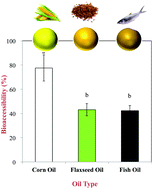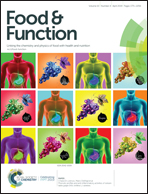Fabrication of plant-based vitamin D3-fortified nanoemulsions: influence of carrier oil type on vitamin bioaccessibility†
Abstract
The influence of carrier oil type (corn, fish, or flaxseed oil) on the production, stability, and simulated gastrointestinal behavior of vitamin-fortified nanoemulsions was studied. The nanoemulsions were formulated using pea protein as an emulsifier since there is increasing interest in substituting artificial and animal-based food ingredients with natural plant-based alternatives. Lipid digestion and vitamin D3 bioaccessibility were measured when the nanoemulsions were subjected to a three-stage in vitro gastrointestinal tract: oral, gastric, and small intestinal. The majority of all three lipids were digested within the first few minutes in the simulated small intestine, with the corn oil nanoemulsions being digested faster than the fish or flaxseed oils. Moreover, a greater fraction of triglycerides were digested by the end of the small intestine for the corn oil than for the fish and flaxseed oils. For the different carrier oils, vitamin bioaccessibility was ranked: corn oil > flaxseed oil ≈ fish oil. These results suggest that monounsaturated-rich oils (such as corn oil) are better for encapsulating and delivering vitamin D3 than polyunsaturated-rich ones (such as flaxseed or fish oil). The insights gained here may aid in the formulation of more efficacious vitamin-fortified foods and beverages from plant-derived ingredients.



 Please wait while we load your content...
Please wait while we load your content...